The Influence of Lobbies: Analyzing Group Consensus from a Physics Approach
Abstract
:1. Introduction
2. Analytical and Computational Approaches to Opinion Spreading
3. Rumors and Lobbies in Galam’s Model
3.1. The Model without Lobby
- individuals are randomly distributed to the available seats;
- individuals change their opinion according to a local or table majority rule, i.e., at each table, if , then all individuals sitting at the table will change to the opinion ; vice versa, if , then all the individuals sitting at the table will change to opinion .
3.2. The Model with Lobby
- the lobbyists sit at the tables, possibly occupying half of the seats available at each table (if s is an even number), or (if the seats are an odd number) (recall that the symbol indicates the ceiling function);
- non-lobbyist individuals are randomly distributed across the remaining seats;
- the table majority rule is applied to both lobbyists and non-lobbyists and the opinions are updated.
3.3. Simulation Model
Example
4. Results and Discussion
5. Conclusions
Author Contributions
Funding
Data Availability Statement
Conflicts of Interest
Appendix A
- NumAgents ;
- LobbySize ;
- NumberSimulations := 1,000,000.
| Algorithm A1 Compute Transition Frequencies with No Lobby |
|
| Algorithm A2 Compute Transition Frequencies with Lobby |
|
References
- Dominus, S. When the Revolution Came for Amy Cuddy. The New York Times. 18 October 2017. Available online: https://www.nytimes.com/2017/10/18/magazine/when-the-revolution-came-for-amy-cuddy.html (accessed on 5 February 2024).
- Jack, A.; Hill, A. Harvard Fraud Claims Fuel Doubts Over Science of Behaviour. Financial Times. 30 June 2023. Available online: https://www.ft.com/content/846cc7a5-12ee-4a44-830e-11ad00f224f9 (accessed on 5 February 2024).
- Aarts, A.A. et al. [Open Science Collaboration] Estimating the reproducibility of psychological science. Science 2015, 349, aac4716. [Google Scholar] [CrossRef] [PubMed]
- Cialdini, R.B.; Goldstein, N.J. Social influence: Compliance and conformity. Annu. Rev. Psychol. 2004, 55, 591–621. [Google Scholar] [CrossRef] [PubMed]
- Sunstein, C.R. What’s available—Social influences and behavioral economics empirical legal realism: A new social scientific assessment of law and human behavior. Northwest. Univ. Law Rev. 2002, 97, 1295–1314. Available online: https://chicagounbound.uchicago.edu/journal_articles/8621/ (accessed on 5 February 2024).
- Asch, S.E. Studies of independence and conformity: I. A minority of one against a unanimous majority. Psychol. Monogr. Gen. Appl. 1956, 70, 1–70. [Google Scholar] [CrossRef]
- Jung, J.; Bramson, A. A recipe for social change: Indirect minority influence and cognitive rebalancing. In Proceedings of the Annual Conference of the Computational Social Science Society of the Americas: CSSSA 2016, Santa Fe, NM, USA, 17–20 November 2016; Available online: https://computationalsocialscience.org/wp-content/uploads/2016/11/CSSSA_2016_paper_5-1.pdf (accessed on 5 February 2024).
- Jung, J.; Page, S.E.; Miller, J.H.; Bramson, A.; Crano, W.D. The impact of indirect minority influence on diversity of opinion and the magnitude, speed and frequency of social change. In Proceedings of the 2018 International Conference of The Computational Social Science Society of the Americas: CSSSA 2018, Santa Fe, NM, USA, 25–28 October 2018; Available online: https://www.researchgate.net/publication/331073577_The_Impact_of_Indirect_Minority_Influence_on_Diversity_of_Opinion_and_the_Magnitude_Speed_and_Frequency_of_Social_Change_A_Brief_Report (accessed on 5 February 2024).
- Jung, J.; Bramson, A.; Crano, W.D.; Page, S.E.; Miller, J.H. Cultural drift, indirect minority influence, network structure, and their impacts on cultural change and diversity. Am. Psychol. 2021, 76, 1039–1053. [Google Scholar] [CrossRef] [PubMed]
- Ausloos, M.; Dawid, H.; Merlone, U. Spatial interactions in agent-based modeling. In Complexity and Geographical Economics: Topics and Tools; Commendatore, P., Kayam, S., Kubin, I., Eds.; Springer International Publishing Switzerland: Cham, Switzerland, 2015; pp. 353–377. [Google Scholar] [CrossRef]
- Wood, W.; Lundgren, S.; Ouellette, J.A.; Busceme, S.; Blackstone, T. Minority influence: A meta-analytic review of social influence processes. Psychol. Bull. 1994, 115, 323–345. [Google Scholar] [CrossRef] [PubMed]
- Paichler, G. Norms and attitude change I: Polarization and styles of behaviour. Eur. J. Soc. Psychol. 1976, 6, 405–427. [Google Scholar] [CrossRef]
- Moscovici, S.; Personnaz, B. Studies in social influence. J. Exp. Soc. Psychol. 1980, 16, 270–282. [Google Scholar] [CrossRef]
- Moscovici, S.; Lage, E.; Naffrechoux, M. Influence of a consistent minority on the responses of a majority in a color perception task. Sociometry 1969, 32, 365–380. [Google Scholar] [CrossRef]
- Mugny, G.; Papastamou, S. When rigidity does not fail: Individualization and psychologization as resistances to the diffusion of minority innovations. Eur. J. Soc. Psychol. 1980, 10, 43–61. [Google Scholar] [CrossRef]
- Crano, W.D.; Seyranian, V. Majority and minority influence. Soc. Personal. Psychol. Compass 2007, 1, 572–589. [Google Scholar] [CrossRef]
- Maass, A.; Clark, R.D. Hidden impact of minorities: Fifteen years of minority influence research. Psychol. Bull. 1984, 95, 428–450. [Google Scholar] [CrossRef]
- Butera, F.; Mugny, G.; Legrenzi, P.; Perez, J.A. Majority and minority influence, task representation and inductive reasoning. Brit. J. Soc. Psychol. 1996, 35, 123–136. [Google Scholar] [CrossRef]
- Mugny, G. Negotiations, image of the other and the process of minority influence. Eur. J. Soc. Psychol. 1975, 5, 209–228. [Google Scholar] [CrossRef]
- Zollman, K.J.S. Social network structure and the achievement of consensus. Politics Philos. Econ. 2012, 11, 26–44. [Google Scholar] [CrossRef]
- Zollman, K.J.S. The epistemic benefit of transient diversity. Erkenntnis 2010, 72, 17–35. [Google Scholar] [CrossRef]
- Gibbard, A. Manipulation of voting schemes: A general result. Econometrica 1973, 41, 587–601. [Google Scholar] [CrossRef]
- Gibbard, A. Manipulation of schemes that mix voting with chance. Econometrica 1977, 45, 665–681. [Google Scholar] [CrossRef]
- Dong, J.-Y.; Lu, X.-Y.; Li, H.-C.; Wan, S.-P.; Yang, S.-Q. Consistency and consensus enhancing in group decision making with interval-valued intuitionistic multiplicative preference relations based on bounded confidence. Inform. Sci. 2024, 652, 119727. [Google Scholar] [CrossRef]
- Zou, W.-C.; Wan, S.-P.; Dong, J.-Y. Trust evolution based minimum adjustment consensus framework with dynamic limited compromise behavior for probabilistic linguistic large scale group decision-making. Inform. Sci. 2024, 652, 119724. [Google Scholar] [CrossRef]
- Heft, A.; Buehling, K. Measuring the diffusion of conspiracy theories in digital information ecologies. Convergence 2022, 28, 940–961. [Google Scholar] [CrossRef]
- Dentith, M.R.X. The Philosophy of Conspiracy Theories; Palgrave Macmillan: London, UK, 2014; Chapter 3. [Google Scholar] [CrossRef]
- Furini, M. Identifying the features of ProVax and NoVax groups from social media conversations. Comput. Hum. Behav. 2021, 120, 106751. [Google Scholar] [CrossRef]
- Rutjens, B.T.; Većkalov, B. Conspiracy beliefs and science rejection. Curr. Opin. Psychol. 2022, 46, 101392. [Google Scholar] [CrossRef] [PubMed]
- Albarracín, D. Processes of persuasion and social influence in conspiracy beliefs. Curr. Opin. Psychol. 2022, 48, 101463. [Google Scholar] [CrossRef]
- Galam, S. Modelling rumors: The no plane Pentagon French hoax case. Phys. Stat. A Mech. Appl. 2003, 320, 571–580. [Google Scholar] [CrossRef]
- Galam, S. Sociophysics: A Physicist’s Modeling of Psycho-Political Phenomena; Springer Science+Business Media, LLC: New York, NY, USA, 2012. [Google Scholar] [CrossRef]
- Galam, S.; Moscovici, S. Towards a theory of collective phenomena: Consensus and attitude changes in groups. Eur. J. Soc. Psychol. 1991, 21, 49–74. [Google Scholar] [CrossRef]
- Berger, L.R. A necessary and sufficient condition for reaching a consensus using DeGroot’s method. J. Am. Stat. Assoc. 1981, 76, 415–418. [Google Scholar] [CrossRef]
- DeGroot, M.H. Reaching a consensus. J. Am. Stat. Assoc. 1974, 69, 118–121. [Google Scholar] [CrossRef]
- Potters, J.; van Winden, F. Lobbying and asymmetric information. Public Choice 1992, 74, 269–292. [Google Scholar] [CrossRef]
- Nyczka, P.; Sznajd-Weron, K. Anticonformity or independence?–Insights from statistical physics. J. Stat. Phys. 2013, 151, 174–202. [Google Scholar] [CrossRef]
- Rouchier, J.; Thoyer, S. Modelling a European decision making process with heterogeneous public opinion and lobbying: The case of the authorization procedure for placing genetically modified organisms on the market. In Multi-Agent-Based Simulation III; Hales, D., Edmonds, B., Norling, E., Rouchier, J., Eds.; Springer: Berlin/Heidelberg, Germany, 2003; pp. 149–166. [Google Scholar] [CrossRef]
- Jackson, J.C.; Rand, D.; Lewis, K.; Norton, M.I.; Gray, K. Agent-based modeling: A guide for social psychologists. Soc. Psychol. Personal. Sci. 2017, 8, 387–395. [Google Scholar] [CrossRef]
- Smith, E.R.; Conrey, F.R. Agent-based modeling: A new approach for theory building in social psychology. Personal. Soc. Psychol. Rev. 2007, 11, 87–104. [Google Scholar] [CrossRef] [PubMed]
- Rodgers, J.L. The epistemology of mathematical and statistical modeling: A Quiet methodological revolution. Am. Psychol. 2010, 65, 1–12. [Google Scholar] [CrossRef] [PubMed]
- Galam, S.; Gefen (Feigenblat), Y.; Shapir, Y. Sociophysics: A new approach of sociological collective behaviour. I. Mean-behaviour description of a strike. J. Math. Sociol. 1982, 9, 1–13. [Google Scholar] [CrossRef]
- Stauffer, D. A biased review of sociophysics. J. Stat. Phys. 2012, 151, 9–20. [Google Scholar] [CrossRef]
- Merlone, U.; Radi, D. Reaching consensus on rumors. Phys. Stat. A Mech. Appl. 2014, 406, 260–271. [Google Scholar] [CrossRef]
- Ellero, A.; Fasano, G.; Sorato, A. Stochastic model of agent interaction with opinion leaders. Phys. Rev. E 2013, 87, 042806. [Google Scholar] [CrossRef]
- Hare, A.P.; Bales, R.F. Seating position and small group interaction. Sociometry 1963, 26, 480–486. [Google Scholar] [CrossRef]
- Sommer, R. Leadership and group geography. Sociometry 1961, 24, 99–110. [Google Scholar] [CrossRef]
- Strodtbeck, F.L.; Hook, L.H. The social dimensions of a twelve man jury table. Sociometry 1961, 24, 397–415. [Google Scholar] [CrossRef]
- Oestereich, A.L.; Pires, M.A.; Queiròs, S.M.D.; Crokidakis, N. Phase transition in the Galam’s majority-rule model with information-mediated independence. Physics 2023, 5, 911–922. [Google Scholar] [CrossRef]
- Newmark, A.; Nownes, A.J. All of the above: Lobbying allied, undecided, and opposing lawmakers in committee and on the floor. Polit. Res. Quart. 2022, 76, 578–592. [Google Scholar] [CrossRef]
- Kemeny, J.G.; Snell, J.L. Finite Markov Chains; Springer: New York, NY, USA, 1960; Available online: https://archive.org/details/finitemarkovchai0000unse (accessed on 5 February 2024).
- The On-Line Encyclopedia of Integer Sequences (OEIS). The OEIS Foundation Inc. 2023. Available online: https://oeis.org/A000041 (accessed on 5 February 2024).
- Feller, W. An Introduction to Probability Theory and Its Applications. Volume 1; John Wiley & Sons Inc.: New York, NY, USA, 1968; Available online: https://archive.org/details/introductiontopr0001unse (accessed on 5 February 2024).
- Bouvier, J.B.; Xu, K.; Ornik, M. Quantitative resilience of linear driftless systems. In 2021 Proceedings of the Conference on Control and its Applications; Matinez Diaz, S., Sanfelice, R., Eds.; Society for Industrial and Applied Mathematics: Philadelphia, PA, USA, 2021; pp. 32–39. [Google Scholar] [CrossRef]
- Cinelli, M.; De Francisci Morales, G.; Galeazzi, A.; Quattrociocchi, W.; Starnini, M. The echo chamber effect on social media. Proc. Natl. Acad. Sci. USA 2021, 118, e2023301118. [Google Scholar] [CrossRef]
- Macy, M.; Deri, S.; Ruch, A.; Tong, N. Opinion cascades and the unpredictability of partisan polarization. Sci. Adv. 2019, 5, eaax0754. [Google Scholar] [CrossRef] [PubMed]
- Kanheman, D.; Sibony, O.S.; Sunstein, C.R. Noise: A Flaw in Human Judgment; William Collins/HarperCollinsPublishers: London, UK, 2021; Available online: https://ia804606.us.archive.org/11/items/ar_20211024/BOOKS.YOSSR.COM-Noise-A-Flaw-in-Human-Judgment.pdf (accessed on 5 February 2024).
- Lax, D.A.; Sebenius, J.K. 3D Negotiation: Powerful Tools to Change the Game in Your Most Important Deals; Harvard Business School Press: Boston, MA, USA, 2006. [Google Scholar]
- Zollman, K.J.S. Network epistemology: Communication in epistemic communities. Philos. Compass 2013, 8, 15–27. [Google Scholar] [CrossRef]
- Thorngate, W. “In general” vs. “it depends”: Some comments of the Gergen-Schlenker debate. Personal. Soc. Psychol. Bull. 1976, 2, 404–410. [Google Scholar] [CrossRef]
- Merlone, U.; Radi, D.; Romano, A. Opinion dynamics on networks. In Complex Networks and Nonlinear Dynamics: Social and Economic Interactions; Commendatore, P., Matilla-García, M., Varela, L.M., Cánovas, J.S., Eds.; Springer International Publishing Switzerland: Cham, Switzerland, 2016; pp. 49–63. [Google Scholar] [CrossRef]
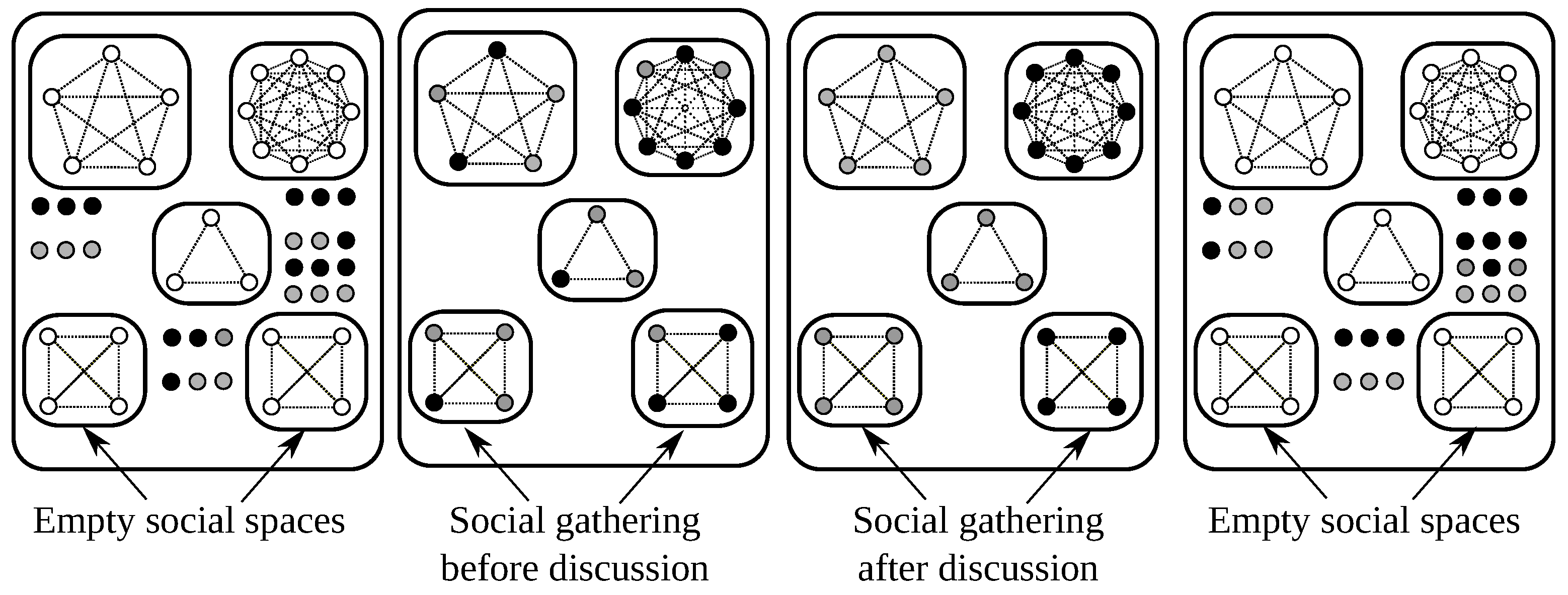
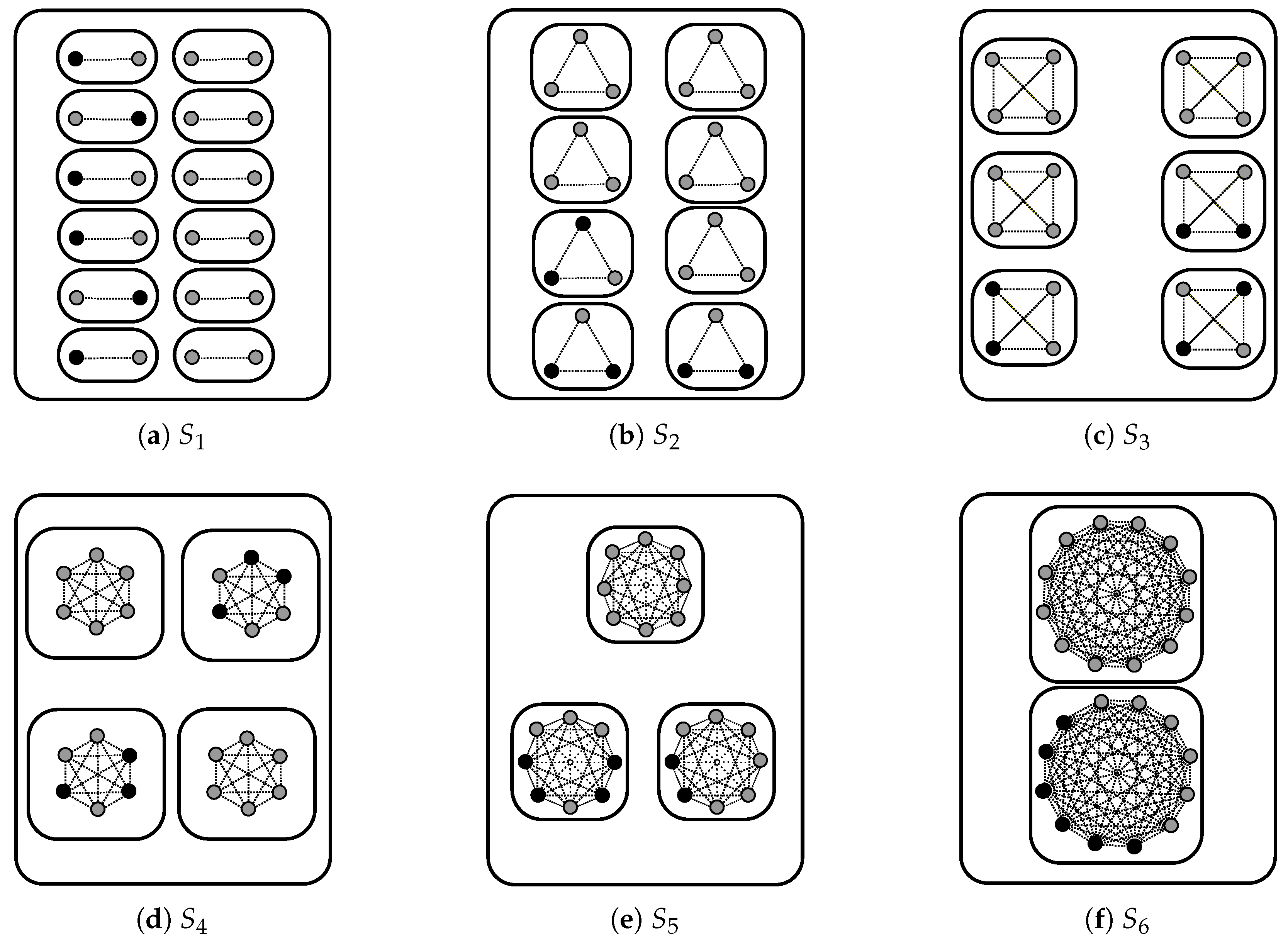


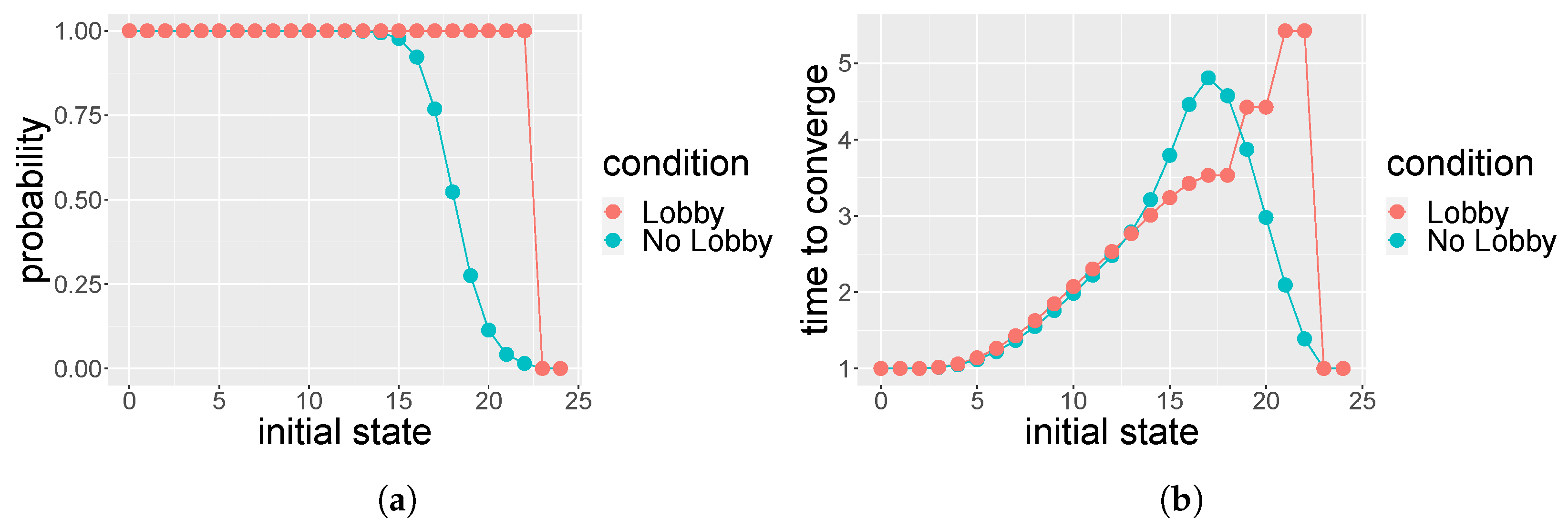


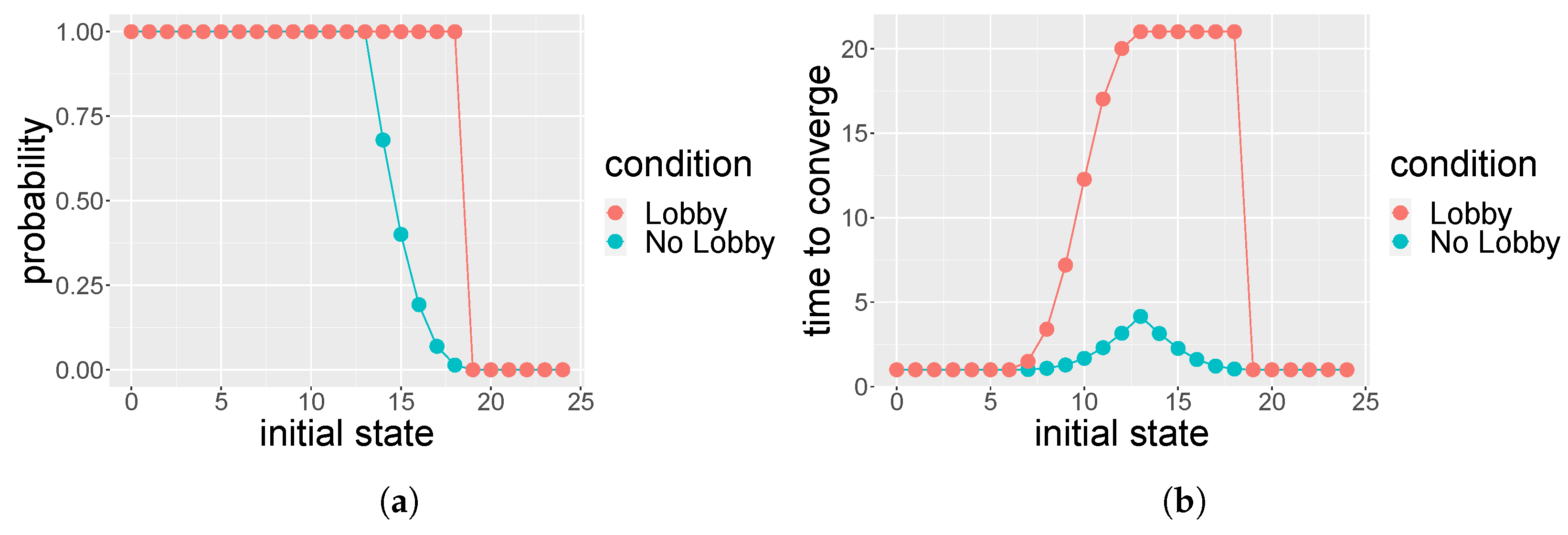

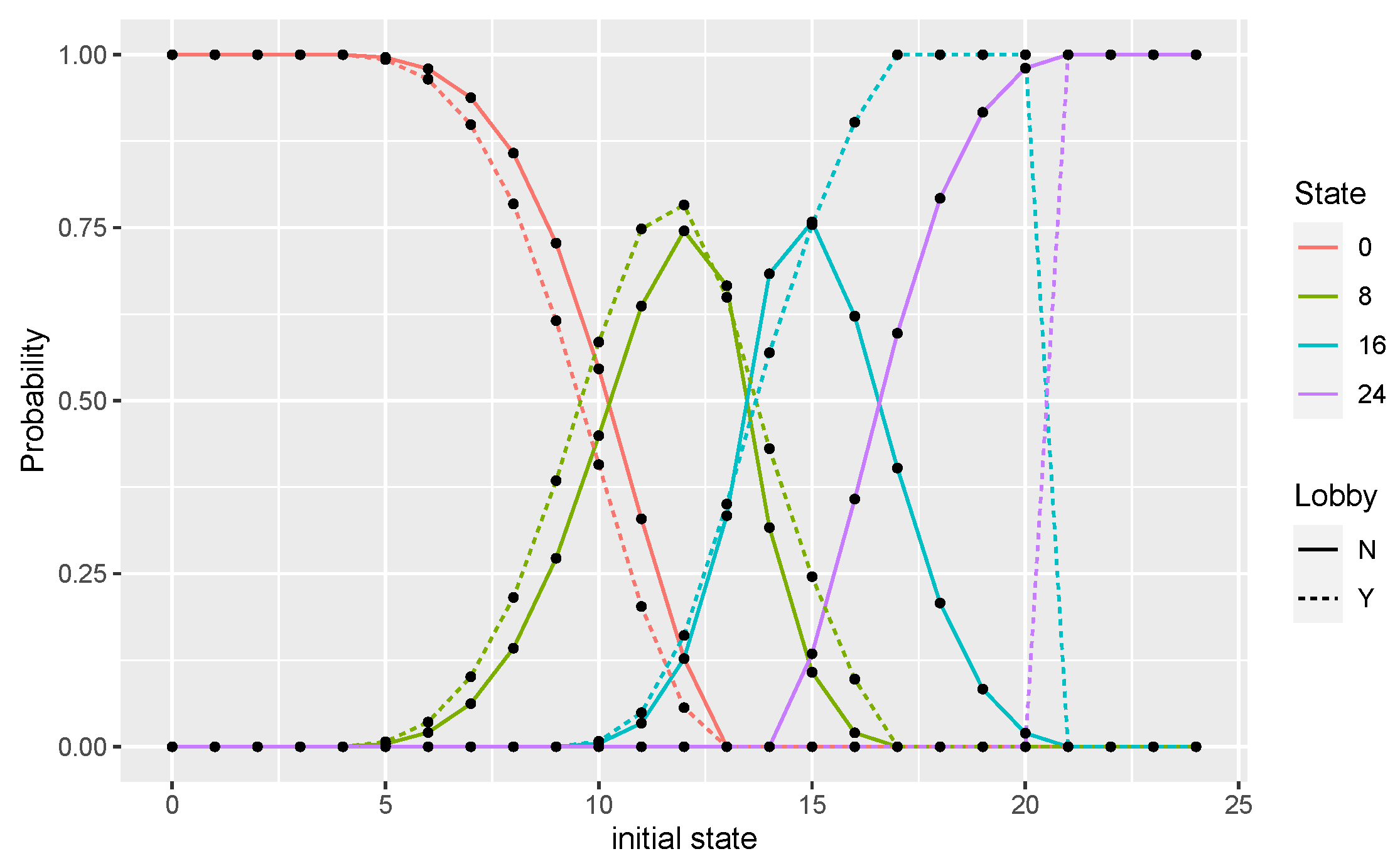
Disclaimer/Publisher’s Note: The statements, opinions and data contained in all publications are solely those of the individual author(s) and contributor(s) and not of MDPI and/or the editor(s). MDPI and/or the editor(s) disclaim responsibility for any injury to people or property resulting from any ideas, methods, instructions or products referred to in the content. |
© 2024 by the authors. Licensee MDPI, Basel, Switzerland. This article is an open access article distributed under the terms and conditions of the Creative Commons Attribution (CC BY) license (https://creativecommons.org/licenses/by/4.0/).
Share and Cite
Merlone, U.; Dal Forno, A. The Influence of Lobbies: Analyzing Group Consensus from a Physics Approach. Physics 2024, 6, 659-673. https://doi.org/10.3390/physics6020043
Merlone U, Dal Forno A. The Influence of Lobbies: Analyzing Group Consensus from a Physics Approach. Physics. 2024; 6(2):659-673. https://doi.org/10.3390/physics6020043
Chicago/Turabian StyleMerlone, Ugo, and Arianna Dal Forno. 2024. "The Influence of Lobbies: Analyzing Group Consensus from a Physics Approach" Physics 6, no. 2: 659-673. https://doi.org/10.3390/physics6020043
APA StyleMerlone, U., & Dal Forno, A. (2024). The Influence of Lobbies: Analyzing Group Consensus from a Physics Approach. Physics, 6(2), 659-673. https://doi.org/10.3390/physics6020043




